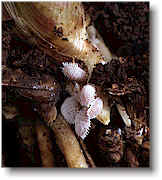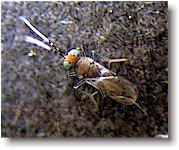| m |

|
|
The pink pineapple mealybug feeding near
the soil surface on the roots of Rhodes grass.
M |
Pineapple crops
worldwide are infested by tiny insects called mealybugs which feed on the pineapple plant
sap. Mealybugs may cause pineapple growers problems because they may impact the size of
pineapple fruit due to withdrawn of plant nutrients; they produce large volumes of the
sweet liquid called "honeydew" that makes the pineapple fruit sticky and black
colored from an associated fungus called sooty mold; and they transmit and interact with
plant pathogens, thought to be closteroviruses, that often kill the pineapple plants if
the plants are stressed via mealybug feeding. In Hawaii, the most common mealybug
infesting pineapple is the pink pineapple mealybug, Dysmicoccus brevipes
(Cockerell), (Homoptera: Pseudococcidae). A close cousin called the gray pineapple
mealybug, Dysmicoccus neobrevipes Beardsley, may also be found in fields.
| fff |

|
|
The Big-headed ant tends mealybugs on
pineapple.
cccc |
Like aphids, mealybugs are often found in association with ants (e.g., the
big-headed ant) that carefully oversee the mealybugs, providing protection in exchange for
the sweet honeydew liquid. The ants protect the mealybugs from their natural enemies such
as small wasps that act as parasites on the mealybugs and from predators such as ladybugs.
They also aid in the elimination of excess honeydew that can reduce the growth of mealybug
colonies because the mealybugs become entangled in the accumulated honeydew. The presence
of the ants is very important to the mealybugs’ survival, and elimination of the ants
using poisonous ant baits, will usually mean the destruction of the mealybug colonies.
Thereby, farmers routinely use ant baits in their pineapple fields to eliminate the
mealybugs’ guardians. Although this is an efficient and evidently safe management
system, farmers have no "backup" control systems if the ant baits suddenly
become unavailable or less effective.
The research goals of this project are to determine the potential of using
periodic releases of one of the pink pineapple mealybugs’ most effective natural
enemies, the encyrtid parasitoid Anagyrus ananatis Gahan. Field data indicate that
this natural enemy can be found attacking mealybugs in the presence of ants, although its
impact on mealybug mortality is low. Laboratory studies indicate that the parasitoid is
only scared away from mealybugs when ants are present, but are rarely killed like
predators such as the ladybugs. When ants are absent, the parasitoid is highly effective
in lowering the mealybug populations in pineapple plantings.
| d |

|
|
The encyrtid parasitoid Anagyrus
ananatis is a highly effective natural enemy of the pink pineapple mealybug in the
absence of ants.
d |
Before one can conduct periodic releases of millions of Anagyrus
ananatis, they first must be reared. This requires the rearing of larger numbers of
the mealybugs in the laboratory to feed the parasitoids so they can reproduce. Until
recently, it was difficult to efficiently rear large numbers of the pink pineapple
mealybug in the laboratory because individuals often fell off of the squash fruit used as
a food source and they often got stuck in their own honeydew because the ants were not
present to eliminate the honeydew. Solving these problems turned out to be very simple,
but contrary to logical thinking. Mealybug-infested squash were actually buried in a
substrate called vermiculite which consists of light and absorbent particles that flow
like sand or fine soil. It is commonly used around agricultural laboratories in growing
plants. An average sized squash (12–16 cm long & about 0.5–1.0 kg) produced
about 4,000 large 3rd instar and adult (> 0.85 mm in size) and 2,500 2nd instar and
small 3rd instar (0.5–0.85 mm in size) mealybugs 5 – 7 weeks after initial
infestation with 1,000 – 2,000 adults. This does not include the numerous crawlers
that would be produced by the mealybug adults. To increase mealybug production efficiency,
studies to enhance crawler settlement on the squash are in progress. Additionally, we are
evaluating the use of growth units that can hold several squash (3 to 6), thereby reducing
personnel hours required to process squash.
Initial monthly production (only 300 individuals) of the parasitoid A.
ananatis was very low given the unlimited supply of mealybugs that we could provide to
mated female parasitoids. The challenge appears to be the manner in which the mealybugs
are exposed to the searching parasitoids. Various methods of exposing the 3rd instar and
adult mealybugs to the parasitoid were tried, and one of the best appears to be the use of
cheesecloth to cover the mealybugs. Use of cheesecloth increased our production by about
6-fold. We are still refining this technique.